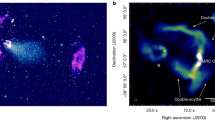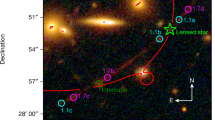Abstract
RADIO observations of the strong, flat-spectrum radio source PKS1830–211 revealed a double structure, with a separation of 1 arcsec, suggesting that it might be a gravitationally lensed object1. We have now obtained high-resolution radio images of PKS1830–211 from several interferometric radiotelescope networks, which show an unusual elliptical ring-like structure connecting the two brighter components. The presence of the ring, and the similarity of the two brighter spots, argue strongly that this is indeed a gravitationally lensed system, specifically an Einstein ring in which lens and lensed object are closely aligned. Although the source is close to the galactic plane, it seems that both the lens and background (lensed) object are extragalactic. This object is one hundred times brighter than either of the two previously discovered radio Einstein rings, and is among the six brightest flat-spectrum sources in the sky. Its brightness makes it a peculiar object: it must involve either a chance alignment of a lensing object with an unusually bright background source, or an alignment with a less bright object but amplified to an unusual degree.
Similar content being viewed by others
References
Rao, A. P. & Subrahmanyan, R. Mon. Not. R. astr. Soc. 231, 229–236 (1988).
Thomasson, P. Q. J. R. astr. Soc. 27, 413–431 (1986).
Jauncey, D. L. et al. in Frontiers of VLBI, Proc. Int. Symp. on VLBI Space Observatory Programme and Proc. Millimetre-Wave VLBl Workshop (eds Hirabayashi, H., Inoue, M. & Kobayashi,H.) (Universal Academy Press, Tokyo, 1990).
Einstein, A. Science 84, 506 (1936).
Hewitt, J. N. et al. Nature 333, 537–540 (1988).
Langston, G. I. et al. Astr. J. 97, 1283–1290 (1989).
Blandford, R. D. & Kochanek, C. S. Astrophys. J. 321, 658–675 (1987).
Subrahmanyan, R., Narasimha, D., Rao, A. P. & Swarup, G. Mon. Not. R. astr. Soc. 246, 263–272 (1990).
de Vaucouleurs, G., de Vaucouleurs, A. & Corwin, H. G. Second Reference Catalogue of Bright Galaxies, 32 (University of Texas Press, 1976).
Refsdal, S. Mon. Not. R. astr. Soc. 128, 295–306 (1964).
Wall, J. V., Shimmins, A. J. & Merkelijn, J. K. Aust. J. Phys. Astrophys. Suppl. no. 19 (1971).
Press, W. H. & Gunn, J. E. Astrophys. J. 185, 397–412 (1973).
Langston, G. I., Conner, S. R., Lehar, J., Burke, B. F. & Weiler, K. W. Nature 344, 43–45 (1990).
Kochanek, C. S., Blandford, R. D., Lawrence, C. R. & Narayan, R. Mon. Not. R. astr. Soc. 238, 43–56 (1989).
Zensus, J. A. & Pearson, T. J. IAU Symp. No. 129: The Impact of VLBI on Astrophysics and Geophysics (eds Reid, M. J. & Moran, J. M.) 7–16 (Kluwer, Dordrecht, 1988).
Wall, J. V. & Peacock, J. A. Mon. Not. R. astr. Soc. 216, 173–192 (1985).
Hewitt, J. N. et al. Lecture Notes in Physics 330: Gravitational Lenses (eds Moran, J. M., Hewitt, J. N. & Lo, K. Y.) 147–157 (Springer, Berlin, 1989).
Author information
Authors and Affiliations
Rights and permissions
About this article
Cite this article
Jauncey, D., Reynolds, J., Tzioumis, A. et al. An unusually strong Einstein ring in the radio source PKS1830–211. Nature 352, 132–134 (1991). https://doi.org/10.1038/352132a0
Received:
Accepted:
Issue Date:
DOI: https://doi.org/10.1038/352132a0
- Springer Nature Limited
This article is cited by
-
Astrometrically registered maps of H2O and SiO masers toward VX Sagittarii
Nature Communications (2018)
-
Central engine of a gamma-ray blazar resolved through the magnifying glass of gravitational microlensing
Nature Physics (2015)
-
Strong field gravitational lensing in stringy black hole
Astrophysics and Space Science (2015)
-
The redshift of the gravitational lens of PKS1830–211 determined from molecular absorption lines
Nature (1996)
-
The optics of cosmology
Nature (1996)





